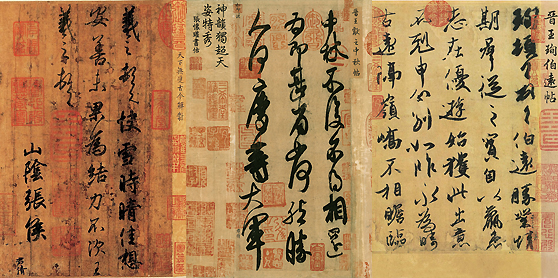Top 10 calligraphy masterpieces of ancient China
- By Xu Lin
 0 Comment(s)
0 Comment(s) Print
Print E-mail
China.org.cn, November 11, 2011
E-mail
China.org.cn, November 11, 2011

Three Rarities of Calligraphy (《三希寶帖》)
|
Three Rarities of Calligraphy |
The "Three Rarities of Calligraphy" refer to the three masterpieces of Wang Xizhi family in Eastern Jin Dynasty (316-420): "Timely Clearing After Snowfall" (《快雪時晴帖》) by Wang Xizhi, "Mid-Autumn Festival" (《中秋帖》) by Wang Xianzhi, and "Letter to Boyuan" (《伯遠帖》) by Wang Xun.
They are the earliest authentic works of Chinese calligraphy that have been discovered so far. In 1746, Emperor Qianlong of the Qing Dynasty (1636-1911) stored these three works in the "Hall of Three Rarities" in Yangxin Hall of the Forbidden City, and named them as "Three Rarities of Calligraphy." They are now housed respectively in the Palace Museum in Beijing and Taipei.
"Timely Clearing After Snowfall" is a 28-character calligraphy work by Wang Xizhi (303-361), which is the only piece of his original work that still exists today. The work, 23 x 14.8 cm, contains four lines. This short letter written in running script, illustrates Wang's exhilaration on a clear day after a snowfall and his greeting to family members. It was praised by Emperor Qianlong as the "28 Shining Beads." There's another saying that this is a copy made in the Tang Dynasty. The work is now one of the top 10 treasures of the National Palace Museum in Taipei.
"Mid-Autumn Festival" is an uncompleted copy of Bao Jin Zhai Fa Tie (《寶晉齋法帖》) and Shi'er Yue Ge Tie (《十二月割帖》) by Wang Xianzhi (344-386), the 7th son of Wang Xizhi. The work, 27 x 11.9 cm, contains three lines and 22 characters. It is one of his most valuable calligraphy works. However, after careful study of the paper and writing brush that the calligrapher used, most scholars believe that this piece is an excellent copy made by the Song Dynasty calligrapher Mi Fu (1051–1107), which is also of great value. The work is currently exhibited in the Palace Museum in Beijing.
"Letter to Boyuan" is a letter written by Wang Xun (350-401), the nephew of Wang Xizhi. Judging from the nervous style of the writing, it is a typical work of his writings. The work, 25.1 x 17.2 cm, contains five lines and 47 characters. It has been collected by the Palace Museum in Beijing.






